Economics Assignment: Australian Post's Monopoly Power and Impact
VerifiedAdded on 2023/01/19
|9
|1811
|90
Report
AI Summary
This economics assignment report analyzes the Australian Post's monopoly power within the Australian market. The report explores the origins of this monopoly, attributed to the Australian Post's exclusive rights and obligations, particularly in rural and remote areas. It examines how the Australian Post benefits from this power, including high-profit margins and the ability to cross-subsidize services, while also acknowledging the harm caused to competitors. The report further discusses the role of government intervention, primarily through the Australian Competition and Consumer Commission, to regulate the Australian Post and prevent exploitation of its market dominance. References from various economic studies and publications support the analysis, highlighting the complexities and impacts of the Australian Post's monopoly on the market and its stakeholders.
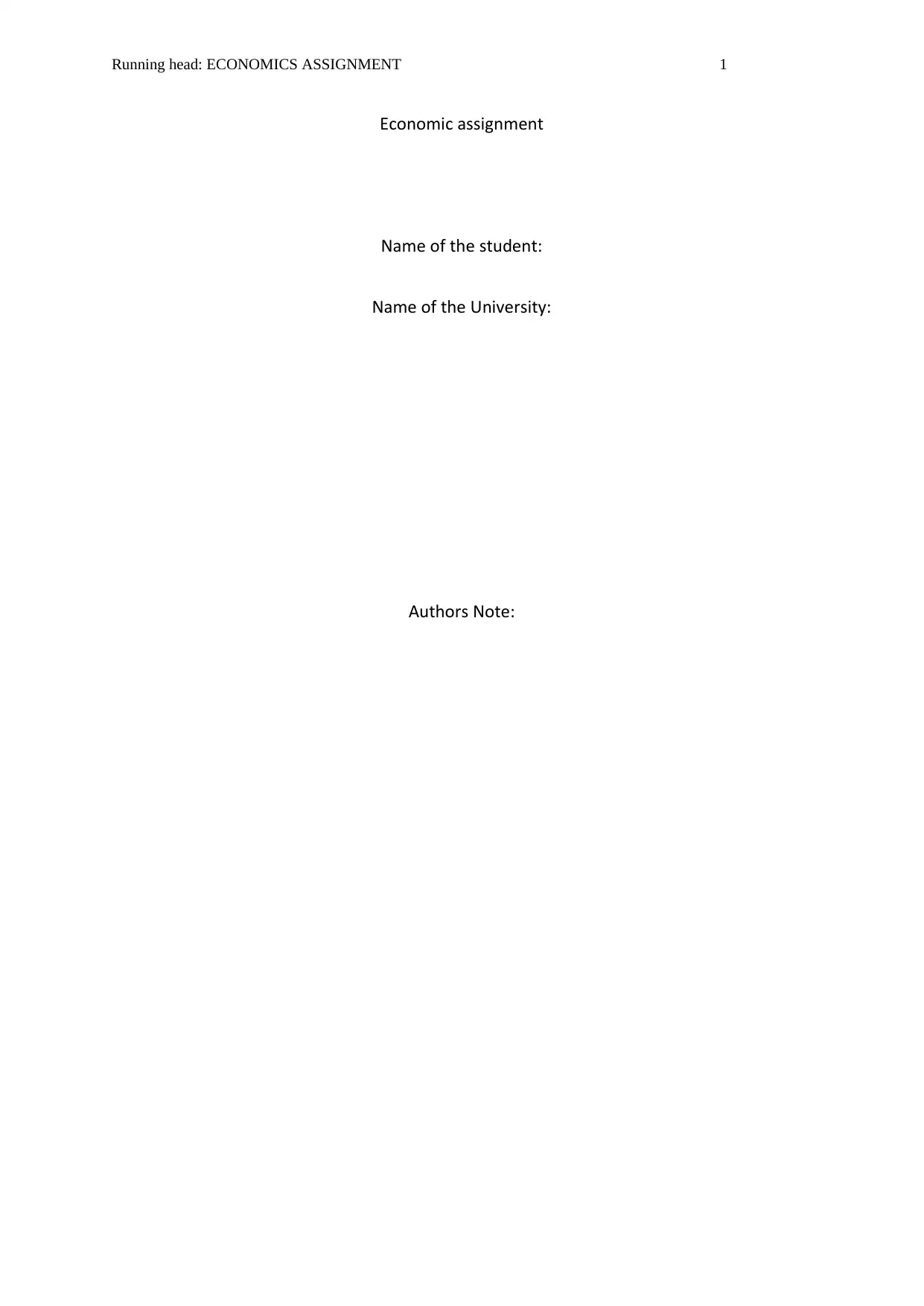
Running head: ECONOMICS ASSIGNMENT 1
Economic assignment
Name of the student:
Name of the University:
Authors Note:
Economic assignment
Name of the student:
Name of the University:
Authors Note:
Paraphrase This Document
Need a fresh take? Get an instant paraphrase of this document with our AI Paraphraser
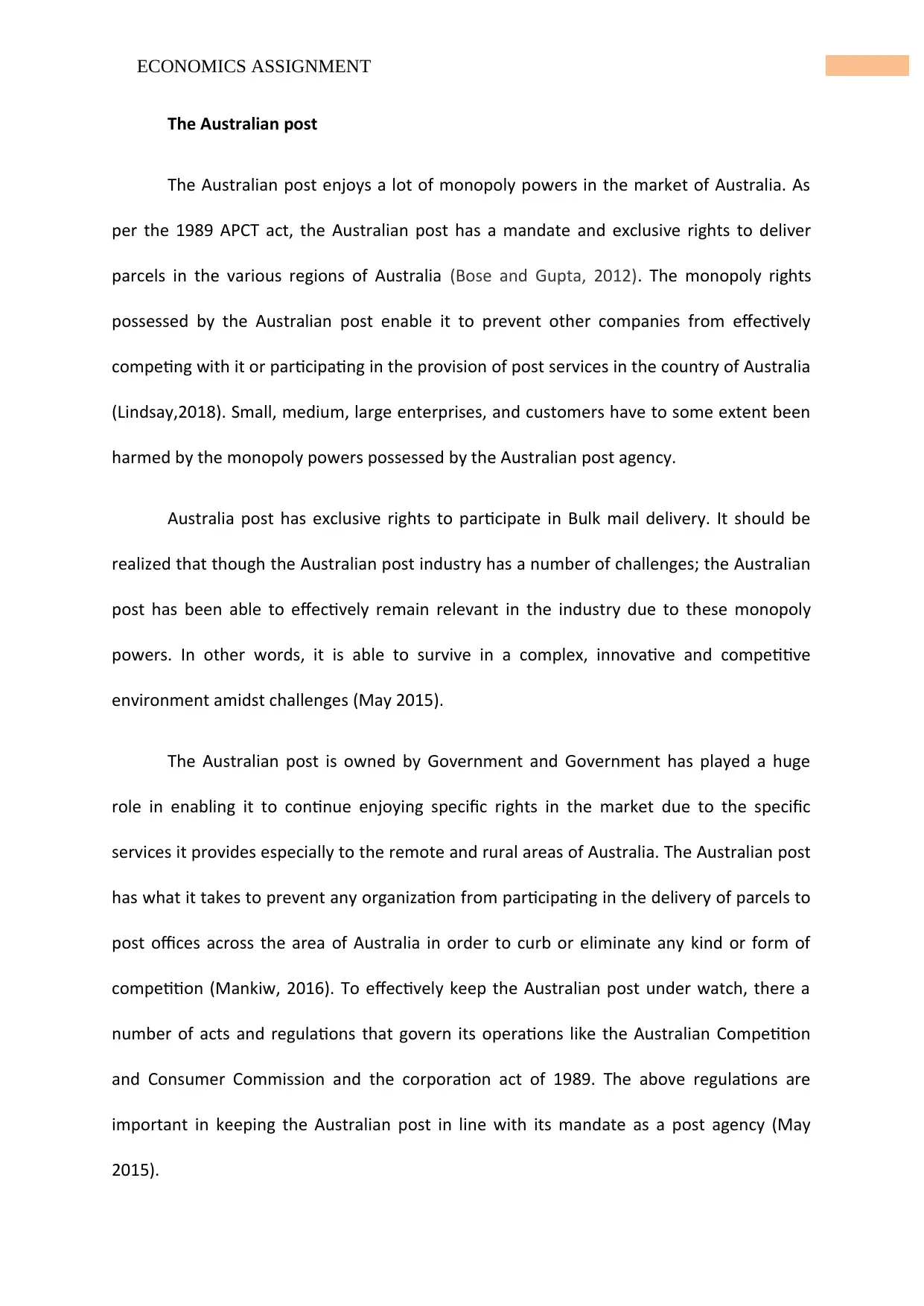
1ECONOMICS ASSIGNMENT
The Australian post
The Australian post enjoys a lot of monopoly powers in the market of Australia. As
per the 1989 APCT act, the Australian post has a mandate and exclusive rights to deliver
parcels in the various regions of Australia (Bose and Gupta, 2012). The monopoly rights
possessed by the Australian post enable it to prevent other companies from effectively
competing with it or participating in the provision of post services in the country of Australia
(Lindsay,2018). Small, medium, large enterprises, and customers have to some extent been
harmed by the monopoly powers possessed by the Australian post agency.
Australia post has exclusive rights to participate in Bulk mail delivery. It should be
realized that though the Australian post industry has a number of challenges; the Australian
post has been able to effectively remain relevant in the industry due to these monopoly
powers. In other words, it is able to survive in a complex, innovative and competitive
environment amidst challenges (May 2015).
The Australian post is owned by Government and Government has played a huge
role in enabling it to continue enjoying specific rights in the market due to the specific
services it provides especially to the remote and rural areas of Australia. The Australian post
has what it takes to prevent any organization from participating in the delivery of parcels to
post offices across the area of Australia in order to curb or eliminate any kind or form of
competition (Mankiw, 2016). To effectively keep the Australian post under watch, there a
number of acts and regulations that govern its operations like the Australian Competition
and Consumer Commission and the corporation act of 1989. The above regulations are
important in keeping the Australian post in line with its mandate as a post agency (May
2015).
The Australian post
The Australian post enjoys a lot of monopoly powers in the market of Australia. As
per the 1989 APCT act, the Australian post has a mandate and exclusive rights to deliver
parcels in the various regions of Australia (Bose and Gupta, 2012). The monopoly rights
possessed by the Australian post enable it to prevent other companies from effectively
competing with it or participating in the provision of post services in the country of Australia
(Lindsay,2018). Small, medium, large enterprises, and customers have to some extent been
harmed by the monopoly powers possessed by the Australian post agency.
Australia post has exclusive rights to participate in Bulk mail delivery. It should be
realized that though the Australian post industry has a number of challenges; the Australian
post has been able to effectively remain relevant in the industry due to these monopoly
powers. In other words, it is able to survive in a complex, innovative and competitive
environment amidst challenges (May 2015).
The Australian post is owned by Government and Government has played a huge
role in enabling it to continue enjoying specific rights in the market due to the specific
services it provides especially to the remote and rural areas of Australia. The Australian post
has what it takes to prevent any organization from participating in the delivery of parcels to
post offices across the area of Australia in order to curb or eliminate any kind or form of
competition (Mankiw, 2016). To effectively keep the Australian post under watch, there a
number of acts and regulations that govern its operations like the Australian Competition
and Consumer Commission and the corporation act of 1989. The above regulations are
important in keeping the Australian post in line with its mandate as a post agency (May
2015).
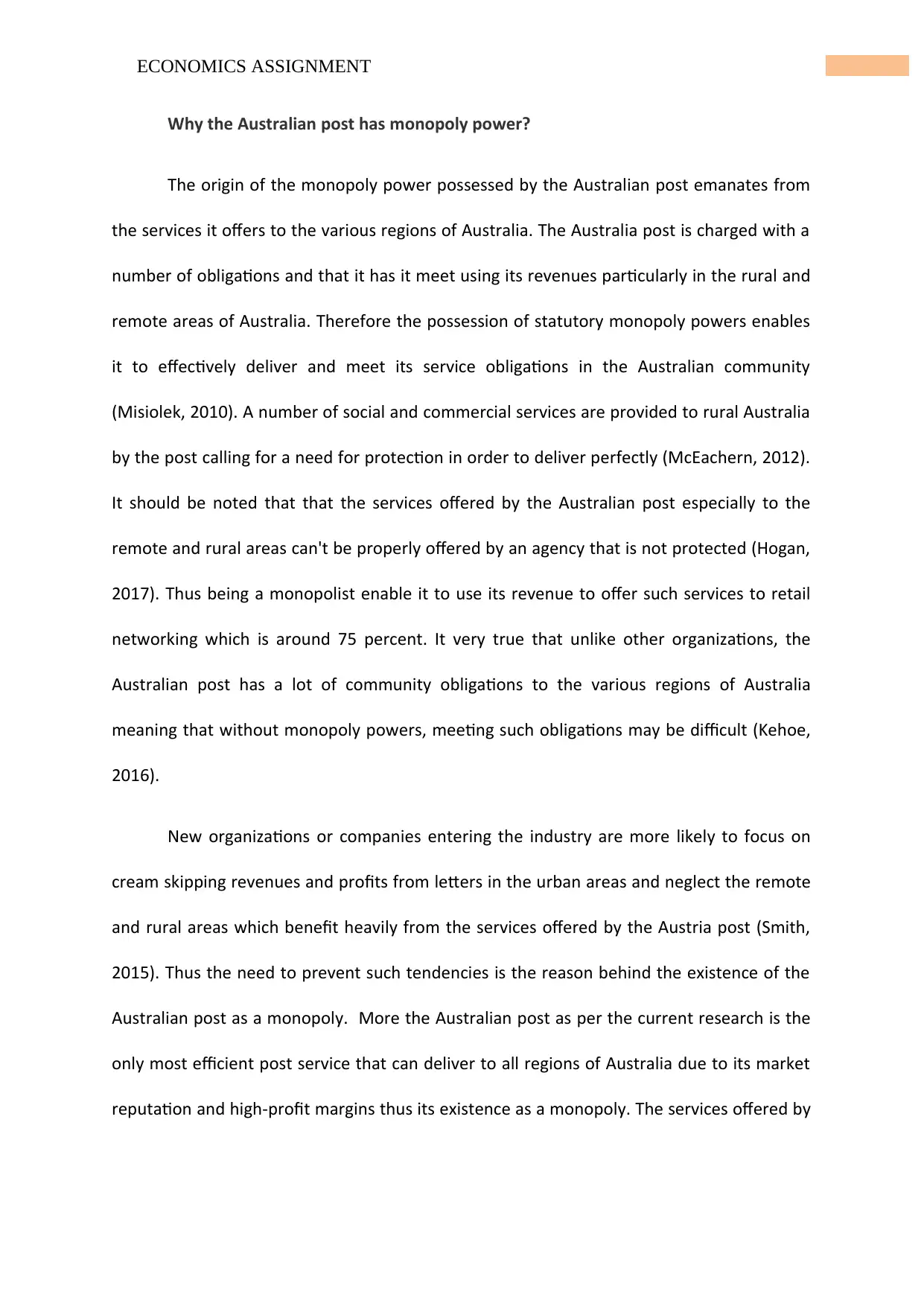
2ECONOMICS ASSIGNMENT
Why the Australian post has monopoly power?
The origin of the monopoly power possessed by the Australian post emanates from
the services it offers to the various regions of Australia. The Australia post is charged with a
number of obligations and that it has it meet using its revenues particularly in the rural and
remote areas of Australia. Therefore the possession of statutory monopoly powers enables
it to effectively deliver and meet its service obligations in the Australian community
(Misiolek, 2010). A number of social and commercial services are provided to rural Australia
by the post calling for a need for protection in order to deliver perfectly (McEachern, 2012).
It should be noted that that the services offered by the Australian post especially to the
remote and rural areas can't be properly offered by an agency that is not protected (Hogan,
2017). Thus being a monopolist enable it to use its revenue to offer such services to retail
networking which is around 75 percent. It very true that unlike other organizations, the
Australian post has a lot of community obligations to the various regions of Australia
meaning that without monopoly powers, meeting such obligations may be difficult (Kehoe,
2016).
New organizations or companies entering the industry are more likely to focus on
cream skipping revenues and profits from letters in the urban areas and neglect the remote
and rural areas which benefit heavily from the services offered by the Austria post (Smith,
2015). Thus the need to prevent such tendencies is the reason behind the existence of the
Australian post as a monopoly. More the Australian post as per the current research is the
only most efficient post service that can deliver to all regions of Australia due to its market
reputation and high-profit margins thus its existence as a monopoly. The services offered by
Why the Australian post has monopoly power?
The origin of the monopoly power possessed by the Australian post emanates from
the services it offers to the various regions of Australia. The Australia post is charged with a
number of obligations and that it has it meet using its revenues particularly in the rural and
remote areas of Australia. Therefore the possession of statutory monopoly powers enables
it to effectively deliver and meet its service obligations in the Australian community
(Misiolek, 2010). A number of social and commercial services are provided to rural Australia
by the post calling for a need for protection in order to deliver perfectly (McEachern, 2012).
It should be noted that that the services offered by the Australian post especially to the
remote and rural areas can't be properly offered by an agency that is not protected (Hogan,
2017). Thus being a monopolist enable it to use its revenue to offer such services to retail
networking which is around 75 percent. It very true that unlike other organizations, the
Australian post has a lot of community obligations to the various regions of Australia
meaning that without monopoly powers, meeting such obligations may be difficult (Kehoe,
2016).
New organizations or companies entering the industry are more likely to focus on
cream skipping revenues and profits from letters in the urban areas and neglect the remote
and rural areas which benefit heavily from the services offered by the Austria post (Smith,
2015). Thus the need to prevent such tendencies is the reason behind the existence of the
Australian post as a monopoly. More the Australian post as per the current research is the
only most efficient post service that can deliver to all regions of Australia due to its market
reputation and high-profit margins thus its existence as a monopoly. The services offered by
⊘ This is a preview!⊘
Do you want full access?
Subscribe today to unlock all pages.

Trusted by 1+ million students worldwide
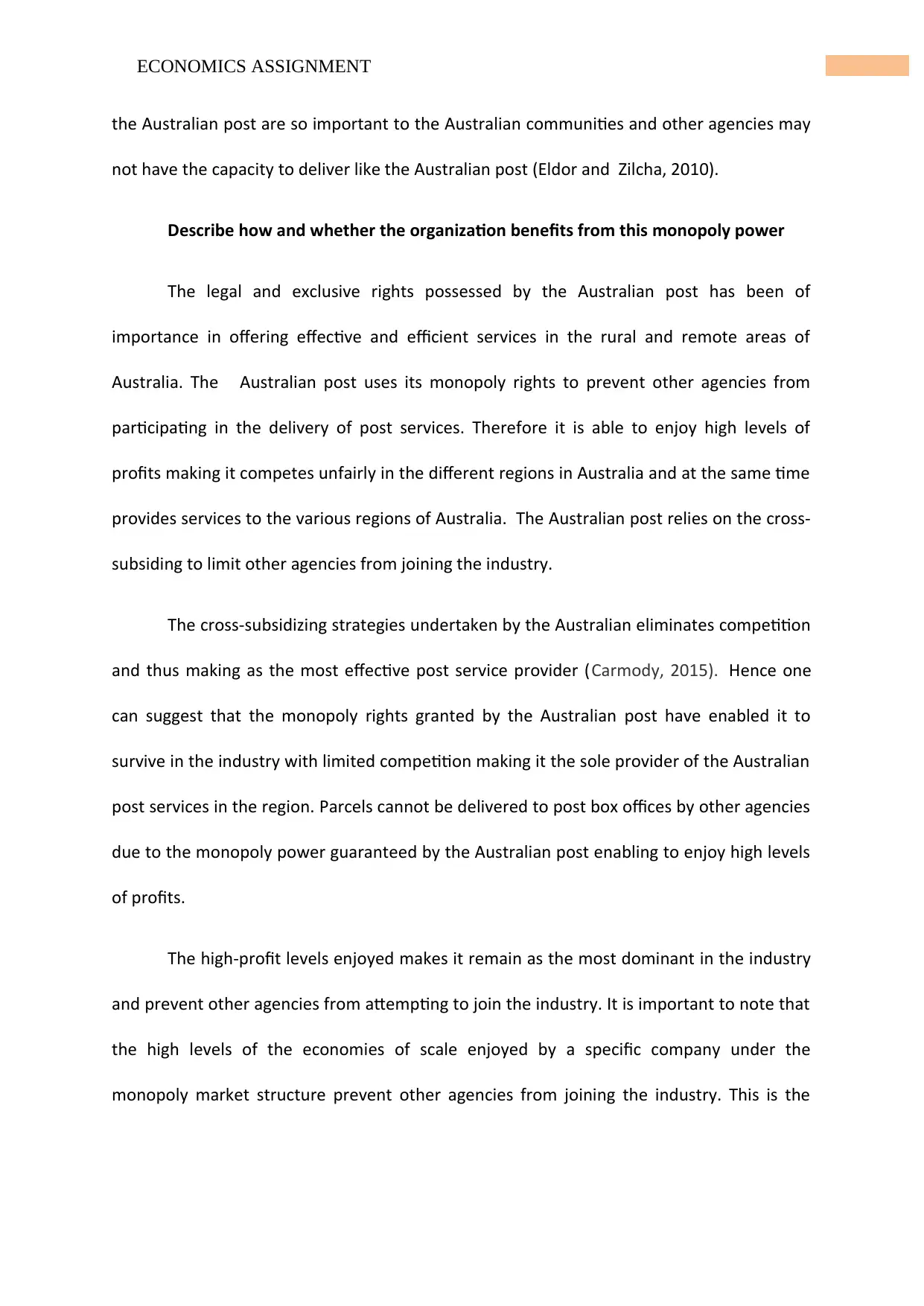
3ECONOMICS ASSIGNMENT
the Australian post are so important to the Australian communities and other agencies may
not have the capacity to deliver like the Australian post (Eldor and Zilcha, 2010).
Describe how and whether the organization benefits from this monopoly power
The legal and exclusive rights possessed by the Australian post has been of
importance in offering effective and efficient services in the rural and remote areas of
Australia. The Australian post uses its monopoly rights to prevent other agencies from
participating in the delivery of post services. Therefore it is able to enjoy high levels of
profits making it competes unfairly in the different regions in Australia and at the same time
provides services to the various regions of Australia. The Australian post relies on the cross-
subsiding to limit other agencies from joining the industry.
The cross-subsidizing strategies undertaken by the Australian eliminates competition
and thus making as the most effective post service provider (Carmody, 2015). Hence one
can suggest that the monopoly rights granted by the Australian post have enabled it to
survive in the industry with limited competition making it the sole provider of the Australian
post services in the region. Parcels cannot be delivered to post box offices by other agencies
due to the monopoly power guaranteed by the Australian post enabling to enjoy high levels
of profits.
The high-profit levels enjoyed makes it remain as the most dominant in the industry
and prevent other agencies from attempting to join the industry. It is important to note that
the high levels of the economies of scale enjoyed by a specific company under the
monopoly market structure prevent other agencies from joining the industry. This is the
the Australian post are so important to the Australian communities and other agencies may
not have the capacity to deliver like the Australian post (Eldor and Zilcha, 2010).
Describe how and whether the organization benefits from this monopoly power
The legal and exclusive rights possessed by the Australian post has been of
importance in offering effective and efficient services in the rural and remote areas of
Australia. The Australian post uses its monopoly rights to prevent other agencies from
participating in the delivery of post services. Therefore it is able to enjoy high levels of
profits making it competes unfairly in the different regions in Australia and at the same time
provides services to the various regions of Australia. The Australian post relies on the cross-
subsiding to limit other agencies from joining the industry.
The cross-subsidizing strategies undertaken by the Australian eliminates competition
and thus making as the most effective post service provider (Carmody, 2015). Hence one
can suggest that the monopoly rights granted by the Australian post have enabled it to
survive in the industry with limited competition making it the sole provider of the Australian
post services in the region. Parcels cannot be delivered to post box offices by other agencies
due to the monopoly power guaranteed by the Australian post enabling to enjoy high levels
of profits.
The high-profit levels enjoyed makes it remain as the most dominant in the industry
and prevent other agencies from attempting to join the industry. It is important to note that
the high levels of the economies of scale enjoyed by a specific company under the
monopoly market structure prevent other agencies from joining the industry. This is the
Paraphrase This Document
Need a fresh take? Get an instant paraphrase of this document with our AI Paraphraser
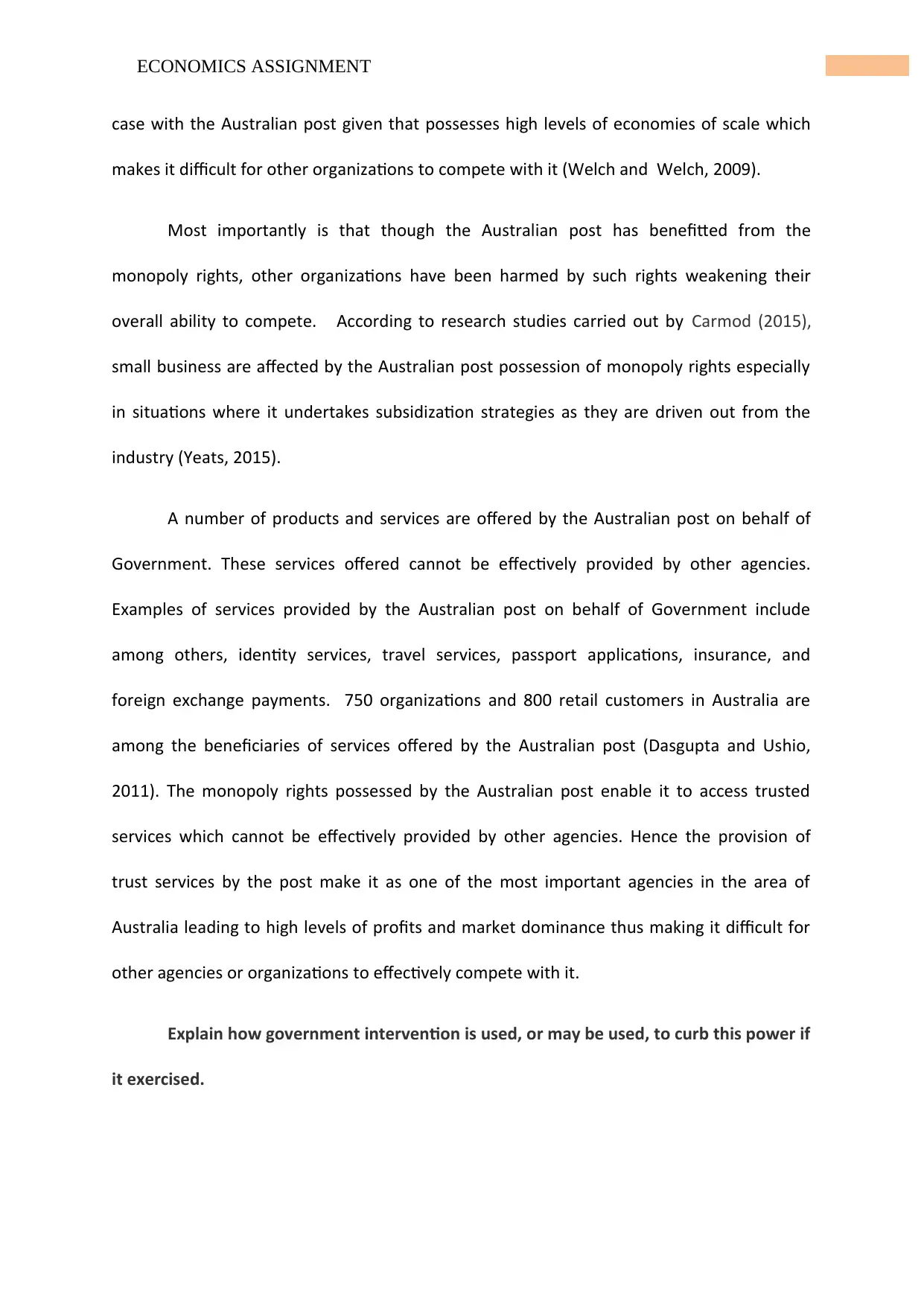
4ECONOMICS ASSIGNMENT
case with the Australian post given that possesses high levels of economies of scale which
makes it difficult for other organizations to compete with it (Welch and Welch, 2009).
Most importantly is that though the Australian post has benefitted from the
monopoly rights, other organizations have been harmed by such rights weakening their
overall ability to compete. According to research studies carried out by Carmod (2015),
small business are affected by the Australian post possession of monopoly rights especially
in situations where it undertakes subsidization strategies as they are driven out from the
industry (Yeats, 2015).
A number of products and services are offered by the Australian post on behalf of
Government. These services offered cannot be effectively provided by other agencies.
Examples of services provided by the Australian post on behalf of Government include
among others, identity services, travel services, passport applications, insurance, and
foreign exchange payments. 750 organizations and 800 retail customers in Australia are
among the beneficiaries of services offered by the Australian post (Dasgupta and Ushio,
2011). The monopoly rights possessed by the Australian post enable it to access trusted
services which cannot be effectively provided by other agencies. Hence the provision of
trust services by the post make it as one of the most important agencies in the area of
Australia leading to high levels of profits and market dominance thus making it difficult for
other agencies or organizations to effectively compete with it.
Explain how government intervention is used, or may be used, to curb this power if
it exercised.
case with the Australian post given that possesses high levels of economies of scale which
makes it difficult for other organizations to compete with it (Welch and Welch, 2009).
Most importantly is that though the Australian post has benefitted from the
monopoly rights, other organizations have been harmed by such rights weakening their
overall ability to compete. According to research studies carried out by Carmod (2015),
small business are affected by the Australian post possession of monopoly rights especially
in situations where it undertakes subsidization strategies as they are driven out from the
industry (Yeats, 2015).
A number of products and services are offered by the Australian post on behalf of
Government. These services offered cannot be effectively provided by other agencies.
Examples of services provided by the Australian post on behalf of Government include
among others, identity services, travel services, passport applications, insurance, and
foreign exchange payments. 750 organizations and 800 retail customers in Australia are
among the beneficiaries of services offered by the Australian post (Dasgupta and Ushio,
2011). The monopoly rights possessed by the Australian post enable it to access trusted
services which cannot be effectively provided by other agencies. Hence the provision of
trust services by the post make it as one of the most important agencies in the area of
Australia leading to high levels of profits and market dominance thus making it difficult for
other agencies or organizations to effectively compete with it.
Explain how government intervention is used, or may be used, to curb this power if
it exercised.
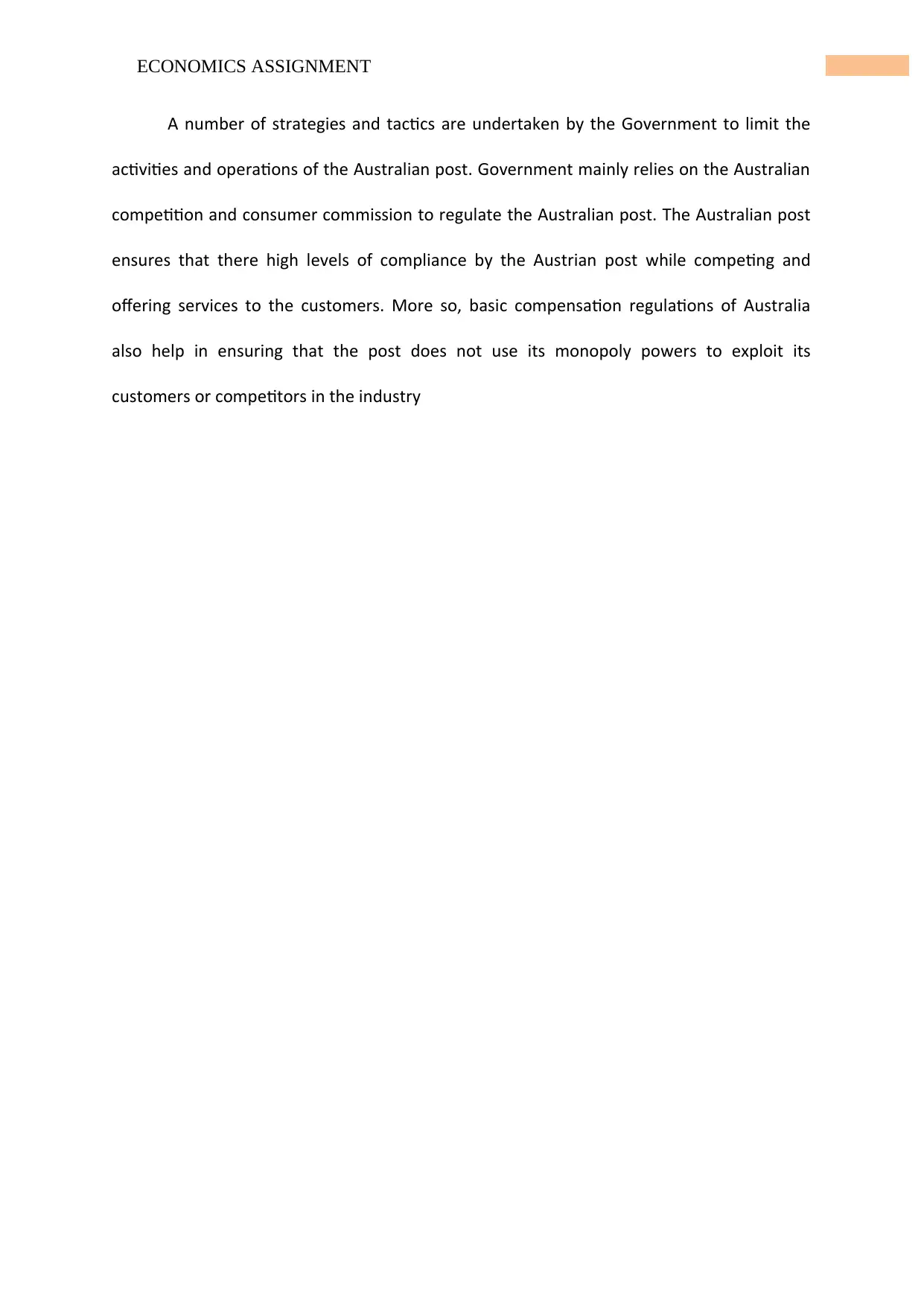
5ECONOMICS ASSIGNMENT
A number of strategies and tactics are undertaken by the Government to limit the
activities and operations of the Australian post. Government mainly relies on the Australian
competition and consumer commission to regulate the Australian post. The Australian post
ensures that there high levels of compliance by the Austrian post while competing and
offering services to the customers. More so, basic compensation regulations of Australia
also help in ensuring that the post does not use its monopoly powers to exploit its
customers or competitors in the industry
A number of strategies and tactics are undertaken by the Government to limit the
activities and operations of the Australian post. Government mainly relies on the Australian
competition and consumer commission to regulate the Australian post. The Australian post
ensures that there high levels of compliance by the Austrian post while competing and
offering services to the customers. More so, basic compensation regulations of Australia
also help in ensuring that the post does not use its monopoly powers to exploit its
customers or competitors in the industry
⊘ This is a preview!⊘
Do you want full access?
Subscribe today to unlock all pages.

Trusted by 1+ million students worldwide
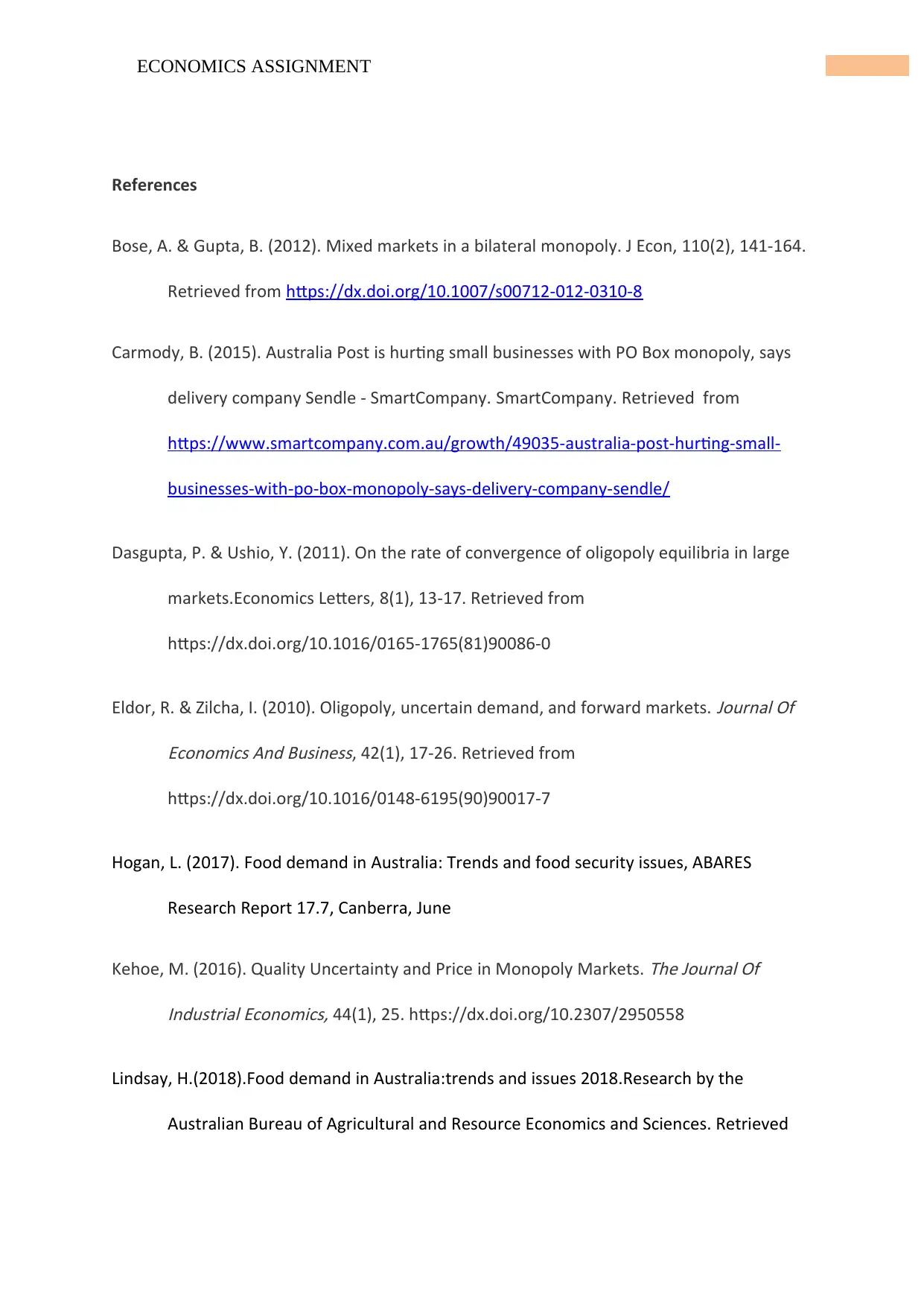
6ECONOMICS ASSIGNMENT
References
Bose, A. & Gupta, B. (2012). Mixed markets in a bilateral monopoly. J Econ, 110(2), 141-164.
Retrieved from https://dx.doi.org/10.1007/s00712-012-0310-8
Carmody, B. (2015). Australia Post is hurting small businesses with PO Box monopoly, says
delivery company Sendle - SmartCompany. SmartCompany. Retrieved from
https://www.smartcompany.com.au/growth/49035-australia-post-hurting-small-
businesses-with-po-box-monopoly-says-delivery-company-sendle/
Dasgupta, P. & Ushio, Y. (2011). On the rate of convergence of oligopoly equilibria in large
markets.Economics Letters, 8(1), 13-17. Retrieved from
https://dx.doi.org/10.1016/0165-1765(81)90086-0
Eldor, R. & Zilcha, I. (2010). Oligopoly, uncertain demand, and forward markets.
Journal Of
Economics And Business, 42(1), 17-26. Retrieved from
https://dx.doi.org/10.1016/0148-6195(90)90017-7
Hogan, L. (2017). Food demand in Australia: Trends and food security issues, ABARES
Research Report 17.7, Canberra, June
Kehoe, M. (2016). Quality Uncertainty and Price in Monopoly Markets.
The Journal Of
Industrial Economics, 44(1), 25. https://dx.doi.org/10.2307/2950558
Lindsay, H.(2018).Food demand in Australia:trends and issues 2018.Research by the
Australian Bureau of Agricultural and Resource Economics and Sciences. Retrieved
References
Bose, A. & Gupta, B. (2012). Mixed markets in a bilateral monopoly. J Econ, 110(2), 141-164.
Retrieved from https://dx.doi.org/10.1007/s00712-012-0310-8
Carmody, B. (2015). Australia Post is hurting small businesses with PO Box monopoly, says
delivery company Sendle - SmartCompany. SmartCompany. Retrieved from
https://www.smartcompany.com.au/growth/49035-australia-post-hurting-small-
businesses-with-po-box-monopoly-says-delivery-company-sendle/
Dasgupta, P. & Ushio, Y. (2011). On the rate of convergence of oligopoly equilibria in large
markets.Economics Letters, 8(1), 13-17. Retrieved from
https://dx.doi.org/10.1016/0165-1765(81)90086-0
Eldor, R. & Zilcha, I. (2010). Oligopoly, uncertain demand, and forward markets.
Journal Of
Economics And Business, 42(1), 17-26. Retrieved from
https://dx.doi.org/10.1016/0148-6195(90)90017-7
Hogan, L. (2017). Food demand in Australia: Trends and food security issues, ABARES
Research Report 17.7, Canberra, June
Kehoe, M. (2016). Quality Uncertainty and Price in Monopoly Markets.
The Journal Of
Industrial Economics, 44(1), 25. https://dx.doi.org/10.2307/2950558
Lindsay, H.(2018).Food demand in Australia:trends and issues 2018.Research by the
Australian Bureau of Agricultural and Resource Economics and Sciences. Retrieved
Paraphrase This Document
Need a fresh take? Get an instant paraphrase of this document with our AI Paraphraser
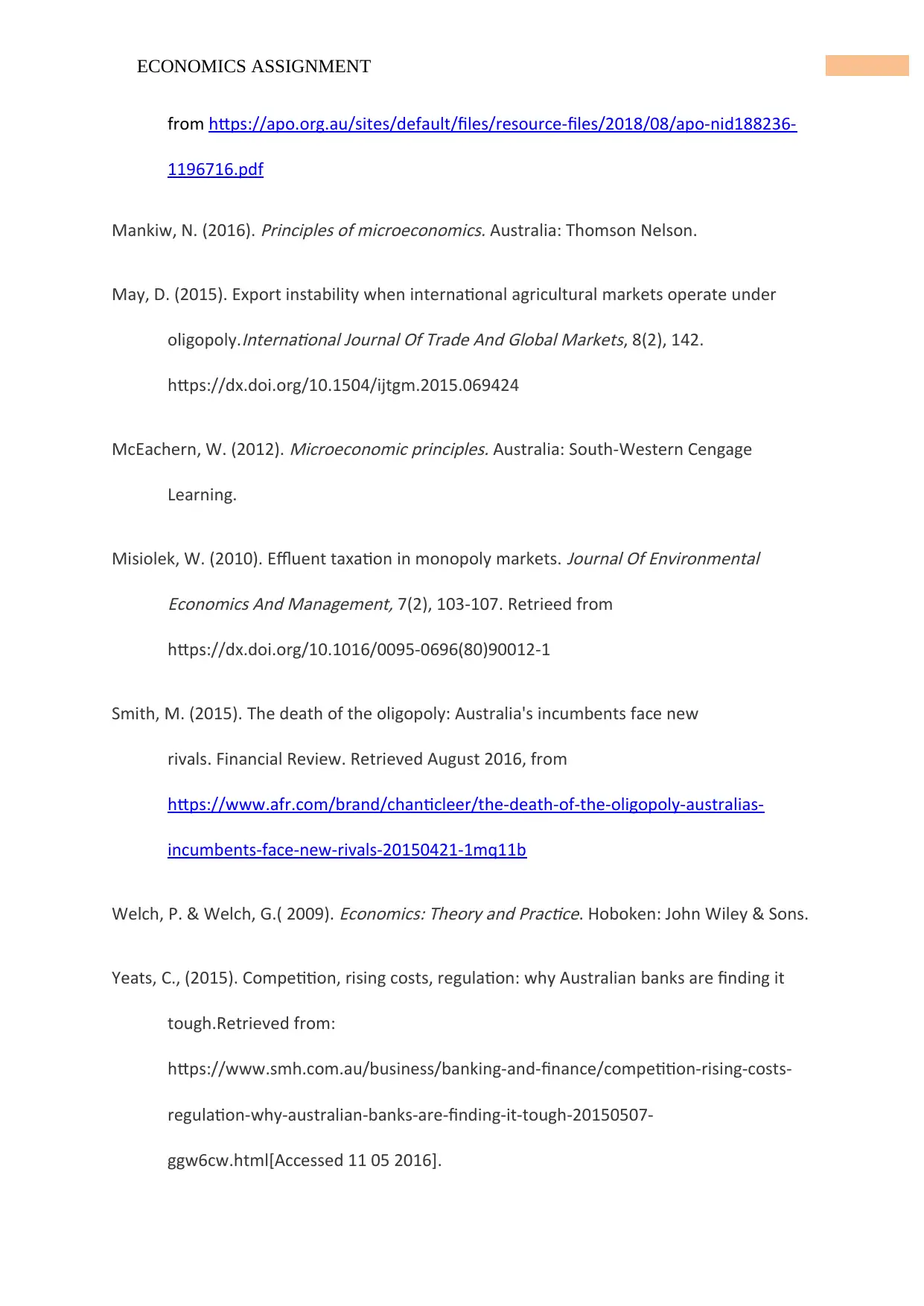
7ECONOMICS ASSIGNMENT
from https://apo.org.au/sites/default/files/resource-files/2018/08/apo-nid188236-
1196716.pdf
Mankiw, N. (2016).
Principles of microeconomics. Australia: Thomson Nelson.
May, D. (2015). Export instability when international agricultural markets operate under
oligopoly.
International Journal Of Trade And Global Markets, 8(2), 142.
https://dx.doi.org/10.1504/ijtgm.2015.069424
McEachern, W. (2012).
Microeconomic principles. Australia: South-Western Cengage
Learning.
Misiolek, W. (2010). Effluent taxation in monopoly markets.
Journal Of Environmental
Economics And Management, 7(2), 103-107. Retrieed from
https://dx.doi.org/10.1016/0095-0696(80)90012-1
Smith, M. (2015). The death of the oligopoly: Australia's incumbents face new
rivals. Financial Review. Retrieved August 2016, from
https://www.afr.com/brand/chanticleer/the-death-of-the-oligopoly-australias-
incumbents-face-new-rivals-20150421-1mq11b
Welch, P. & Welch, G.( 2009).
Economics: Theory and Practice. Hoboken: John Wiley & Sons.
Yeats, C., (2015). Competition, rising costs, regulation: why Australian banks are finding it
tough.Retrieved from:
https://www.smh.com.au/business/banking-and-finance/competition-rising-costs-
regulation-why-australian-banks-are-finding-it-tough-20150507-
ggw6cw.html[Accessed 11 05 2016].
from https://apo.org.au/sites/default/files/resource-files/2018/08/apo-nid188236-
1196716.pdf
Mankiw, N. (2016).
Principles of microeconomics. Australia: Thomson Nelson.
May, D. (2015). Export instability when international agricultural markets operate under
oligopoly.
International Journal Of Trade And Global Markets, 8(2), 142.
https://dx.doi.org/10.1504/ijtgm.2015.069424
McEachern, W. (2012).
Microeconomic principles. Australia: South-Western Cengage
Learning.
Misiolek, W. (2010). Effluent taxation in monopoly markets.
Journal Of Environmental
Economics And Management, 7(2), 103-107. Retrieed from
https://dx.doi.org/10.1016/0095-0696(80)90012-1
Smith, M. (2015). The death of the oligopoly: Australia's incumbents face new
rivals. Financial Review. Retrieved August 2016, from
https://www.afr.com/brand/chanticleer/the-death-of-the-oligopoly-australias-
incumbents-face-new-rivals-20150421-1mq11b
Welch, P. & Welch, G.( 2009).
Economics: Theory and Practice. Hoboken: John Wiley & Sons.
Yeats, C., (2015). Competition, rising costs, regulation: why Australian banks are finding it
tough.Retrieved from:
https://www.smh.com.au/business/banking-and-finance/competition-rising-costs-
regulation-why-australian-banks-are-finding-it-tough-20150507-
ggw6cw.html[Accessed 11 05 2016].

8ECONOMICS ASSIGNMENT
⊘ This is a preview!⊘
Do you want full access?
Subscribe today to unlock all pages.

Trusted by 1+ million students worldwide
1 out of 9
Related Documents
Your All-in-One AI-Powered Toolkit for Academic Success.
+13062052269
info@desklib.com
Available 24*7 on WhatsApp / Email
![[object Object]](/_next/static/media/star-bottom.7253800d.svg)
Unlock your academic potential
Copyright © 2020–2025 A2Z Services. All Rights Reserved. Developed and managed by ZUCOL.





